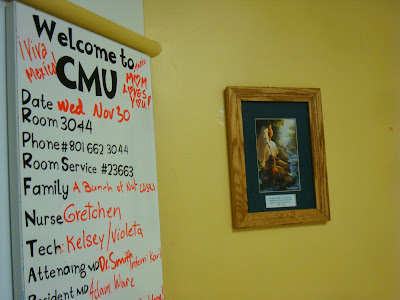WHEN YOU READ THIS YOU WILL SCREAM IT TOOK THEM 6 WEEKS TO FIND, CONSIDERING THIS IS A SEPTIC, (deadly) illness! |
| Matthew horribly ill 30 days after leaving 1 hospital with a "virus" |
It started with Ryan, Hayden and
Allie, then me, then Mateo.
We took him to LDS hospital on
Halloween, because of his fever of 103.6, vomiting and a swollen stiff neck. No
labs, no nothing. Took 5 hours for him to convince them to give him and IV for
all the lost fluids. Was told it was a virus.
For the next 4 weeks, he just sucked
it up, rarely being able to handle being out of bed for more than 3 hours.
Sunday, the 20th, his neck was so swollen and he was really hurting. He went to
the chiropractor, was icing, then heat and ice, then the tens unit, no relief.
The day before Thanksgiving, I took
him to Dr. Wade's office. Sandra, (his wife & CNFP) took blood for
labs and did a rapid strep, which was positive. They gave Matthew 2 IM shots in
his hips of Penicillin and I finally got some Augmentin, since I had been
sick all that time also.
For the next couple of days, for some
reason, (knowing he needed more because he had been SO SICK...) I
gave Matthew some of my antibiotics BID ,
(twice daily) and he also, knowing he needed more because he
had been SO SICK, took them.
Thanksgiving his neck was still so
sore and he was so sick. He came up and joined the family in the evening. We
all watched as he tried to eat and just cried. We all felt so bad and
powerless. The next day I was running around on the west side getting some last
minute things for his "Fiesta" on Sunday. Got home late. He hadn't
eaten. I heated up some Thanksgiving leftovers. He tried to eat. Nada. I
reheated it and cut it into itty bitty pieces like when he was a baby. He
tried. He just sobbed as I held him. It was horrible. About an hour later I
said, "C'mon-we are going to Primary Children's!" He said, "You
wanna pay $15,000.00 for a hospital bill?" (Little did we both know how
true that would be!) I said, "Absolutely! I'd pay more than that not to
lose you!!"
~....To be continued.....~
1 DUMB Dr. WITHOUT ANY LABS , (Matthew
says it's slander and I can be sued if I say more, even if it's TRUE !!!!)
at Primary Children's also tried to send us home! NEITHER of us were havin'
that! I demanded some blood tests and a CT Scan. He refused and said he'd do a
mono panel and an Xray. In his extremely condescending way, as he was
doing his report, (THANK HEAVENS to the doctor that was coming on,) he mocked
us both and you could hear him saying he had a virus and we, and they, and he'd
order...
OOOOOOOOHHHHHH!!
After the Xray, they ordered that needless CT Scan the
irritating mother had asked for and found my son had a Retropharyngeal Abscess
about 1 1/8" x 1 1/4" x 1 3/4" in his neck between his spinal
cord and the back of his throat from being SO SICK for so long!
Well anyways, this is just too long to continue! He was
admitted, put on heavy duty IV antiobiotics. Did not get better. Had surgery.
Was released a few days later.
Matthew was still too weak and tired from being sick for
2 months. We decided since he was going to be delayed 6 weeks, we should have
his tonsils & adnoids out, (luckily his Dr. was a professor at the
University of Utah and thought that it was probably tonsillitis that started it
all. http://healthcare.utah.edu/fad/mddetail.php?physicianID=FM00002859
We scheduled a tonsillectomy and adenoidectomy on Dec
12th. It KICKED Matthew's butt! He is just now barely recovered. Still tires
easier. His 3rd Farewell is tomorrow and he now leaves Wednesday. I am very
worried, as he is still very, very tired.
 |
| Some of his friends down from college visiting.... |
 |
| Gotta have a Greg Olsen pix wherever you go! |
Early recognition and aggressive management of
retropharyngeal abscess are essential because it still carries significant
morbidity and mortality.
he retropharyngeal space is posterior to the pharynx, bound
by the buccopharyngeal fascia anteriorly, the prevertebral fascia posteriorly,
and the carotid sheaths laterally. It extends superiorly to the base of the
skull and inferiorly to the mediastinum.
Abscesses in this space can be caused by the following
organisms:
· Aerobic
organisms, such as beta-hemolytic streptococci and Staphylococcus aureus
· Anaerobic
organisms, such as species of Bacteroides and Veillonella
· Gram-negative
organisms, such as Haemophilus parainfluenzae and Bartonella henselae
The high mortality rate of retropharyngeal abscess is owing
to its association with airway obstruction, mediastinitis, aspiration
pneumonia, epidural abscess, jugular venous thrombosis, necrotizing
fasciitis, sepsis, and erosion into the carotid artery.
Once mediastinitis occurs,
mortality approaches 50%, even with antibiotic therapy. Retropharyngeal abscess
can also cause internal
jugular vein thrombosis, carotid artery erosion, pericarditis,
and epidural abscess. In addition to invasion of contiguous
structures, retropharyngeal abscess can cause sepsis and airway compromise.
In a study of 234 adults with deep space
infections of the neck in Germany ,
the mortality rate was 2.6%. The cause of death was primarily sepsis with
multiorgan failure.[5]
In the United States ,
in 2003, a review of the Kids' Inpatient Database (KID) revealed 1321 pediatric
admissions with RPA, with no fatalities.[2]
A case series from Children's National Medical Center Washington DC
History is variable, depending on the age group. Symptoms of
retropharyngeal abscess are different for adults, children, and infants.
Symptoms
in adults
Sore throat
Fever
Dysphagia
(In dysphagia, the affected person experiences difficulty in swallowing.)
Odynophagia (In
odynophagia, the affected person experiences pain in swallowing.) Neck
pain
Dyspnea
(Shortness of breath or hunger for air)
Retropharyngeal abscess develops secondary to lymphatic
drainage or contiguous spread of upper respiratory or oral infections.
Pharyngeal trauma from endotracheal intubation, nasogastric tube insertion,[12] endoscopy, foreign body ingestion, and foreign body
removal may cause a subsequent retropharyngeal abscess. Patients who are
immunocompromised or chronically ill, such as persons with diabetes, cancer, alcoholism, or AIDS, are
at increased risk for retropharyngeal abscess.
The most common organisms causing retropharyngeal abscesses
include aerobes and anaerobes; gram-negative organisms also may be observed.
Often, mixed flora are cultured.
· Organisms
causing retropharyngeal abscess in adults[13]
o Beta-hemolytic
streptococci
o Streptococcus
viridans
o S
aureus
o Klebsiella
pneumoniae
o Bacteroides species
o Staphylococcus
epidermidis
o Anaerobic
streptococci
o Bartonella
henselae
o Eikenella
corrodens
o Escherichia
coli
o Prevotella species
o Actinomycetes[16]
 |
| Being the EMT he is, heard his SAT level was way low, said IMPOSSIBLE and grabbed the Oxygen! |
Abscesses that are
left untreated can rupture spontaneously into the pharynx leading to
aspiration.
Asphyxia resulting from direct pressure or from sudden rupture of
the abscess and also from hemorrhage is the major complication of these
infections. Other complications include extension of infection laterally to the
side of the neck, or dissection into the posterior mediastinum through facial
planes and the prevertebral space, cerebral abscess, meningitis, and sepsis.
Death can occur from aspiration, airway obstruction, erosion into major blood
vessels, or extension to the mediastinum.
 |
| Immediately after surgery to drain the abscess, he had the girls in stitches! |
Peritonsillar abscess
Quinsy; Abscess - peritonsillar
Last reviewed: November
23, 2010 .
Peritonsillar abscess is a collection of infected material
in the area around the tonsils.
See also:
Causes, incidence, and risk factors
Peritonsillar abscess is a complication of tonsillitis.
It is most often caused by a type of bacteria called group A
beta-hemolytic streptococcus.
Peritonsillar abscess is usually a disease of older
children, adolescents, and young adults. It has become uncommon with the use of
antibiotics to treat tonsillitis.
Symptoms
One or both tonsils become infected. The infection may
spread over the roof of the mouth (palate), and to the neck and chest,
including the lungs. Swollen tissues may block the airway, which is a
life-threatening medical emergency.
The abscess can break open (rupture) into the throat,
infecting or further blocking the airway.
Symptoms of peritonsillar abscess include:
- Chills
- Difficulty
opening the mouth, and pain with opening the mouth
- Difficulty
swallowing
- Drooling or
inability to swallow saliva
- Facial
swelling
- Fever
- Headache
- Muffled
voice
- Sore
throat (may be severe and is usually on one side)
- Tender
glands of the jaw and throat
Signs and tests
An examination of the throat often shows swelling on one
side and on the roof of the mouth.
The uvula in the back of the throat may be shifted away from
the swelling. The neck and throat may be red and swollen on one or both sides.
The following tests may be done:
- Aspiration of
the abscess
- CT
scan
Treatment
If the infection is caught early, you will be given
antibiotics. More likely, if an abscess has developed, it will need to be
drained with a needle or by cutting it open.
Sometimes, the abscess may be drained and the tonsils
removed at the same time. You will be prescribed painkillers.
Expectations (prognosis)
Peritonsillar abscess usually goes away with treatment,
although the infection may return in the future.
Complications
- Airway
obstruction
- Cellulitis of
the jaw, neck, or chest
- Endocarditis (rare)
- Fluid
around the lungs (pleural
effusion)
- Inflammation
around the heart (pericarditis)
- Pneumonia
More info:
 |
| 2nd day at the MTC with his companion and school friend David Coffman...you can see he is still tired...:( |








